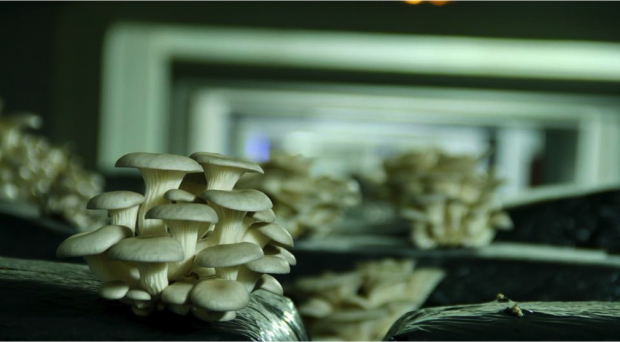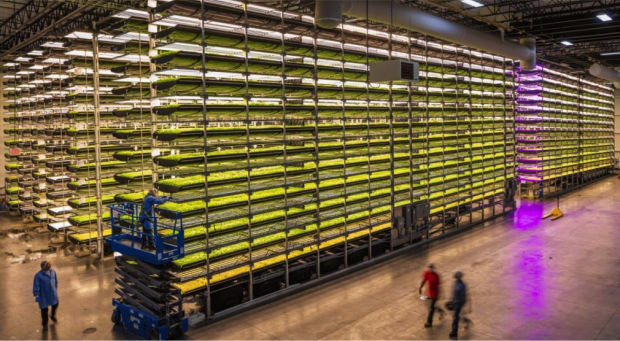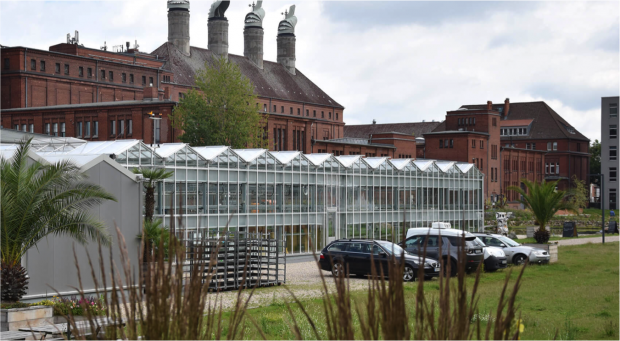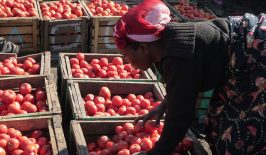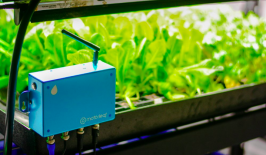The world’s population continues to grow. Currently more than 7.6 billion people live on the planet – and every day there are around 230,000 more of us. Most of the planet’s population lives in cities – more than half of us live in urban spaces, including giant, sprawling densely-populated megacities, a fact which poses us many challenges. All of those people have to be supplied with water, space to live, energy, transportation – and of course enough food to survive.
It might seem unbelievable when we think about the stuffed shelves in the supermarket around the corner, but the way we produce food today is anything but sustainable. First of all, cities only have very limited access to the agricultural areas around them. Secondly, intensive farming and huge amounts of chemicals used that leach out puts stress on our waterways. Extremes of weather, such as droughts and floods, that come with climate change are already making a lot of agricultural land unusable. At the same time, agriculture is responsible for 30 per cent of global CO2 emissions and just transporting the food we eat (which often travels half way around the global before it reaches us) uses huge amounts of energy.
With agricultural areas and global supply chains are set to struggle in the future, cities will have to start producing food themselves and traditional agriculture will need to introduce of weather-resistant and climate- and resource-saving technologies.
Feeding the World With Hydro-, Aqua- and Aeroponics
The world has always had “alternative” agriculture: hanging gardens and greenhouses have existed in different forms for hundreds of years. And the idea of vertical farming – where various different plants grow above each other, is also decades old. The first studies into skyscrapers being used as agricultural spaces developed in the 60s – back then however, it was in the spirit of a crazy utopic idea and not something that could ever be realised in real life.
But new technological developments have seen urban and vertical farming concepts be put into practice – and to a large extent, succeed – bringing back a part of our food production back to the place where it is consumed, and perhaps offering us a practical solution to a fast-approaching problem.
How do those alternative farms look in reality, today? Let’s go on a little journey around the world…
La Caverne – Urban Farming Under the Streets of Paris
The startup Cycloponics built an urban farm in 2017 in a former underground car park that had been empty for years. They grow mushrooms, endive (a member of the chicory family) and various vegetable and herb shoots, also known as microgreens, in an area measuring 3,500 square metres. The young team behind the project was inspired by some concepts from permaculture and set out to create a closed loop of natural resources. The fungi release CO2, which the sprouts absorb as they grow, and all of the organic waste is composted and reused. Since all production takes place underground and all light has to be created artificially, Cycloponics deliberately chose mushrooms that require very little light and chicory that does not require any light at all. The salads and microgreens that do require light are supplied it via energy-saving LEDs – 100 per cent of the electricity for them comes from green electricity. No pesticides are used, meaning all of the produce is organic.
The products are delivered directly to end consumers, small grocery stores and restaurants in the area, meaning short supply chains, low-emission distribution and no need for middle-men, allowing La Caverne to offer its products at competitive prices.
Growing Underground – Shelves of Salad Flourishing in Former Air Raid Shelters
What once provided shelter to civilians in World War II is now the site of a farm full of shelves of salad and herbs. In Clapham in South London, two ecopreneurs founded “Growing Underground” in 2015, a vertical growing space 33 metres underground, in a former air-raid shelter. The plants grow stacked on top of each other in sophisticated hydroponic shelving systems, illuminated by violet LED light, along two long tunnels.
The roots of the plants aren’t in soil, but rather in water-filled containers where they’re fixed in place with coconut fibre or mineral wool. This method of growing – called hydroponics – allows them to receive an optimum supply of nutrients and oxygen and to grow faster. The water used to irrigate the plants runs through a closed circuit, meaning that this system uses 70 per cent less water than would be used on conventional field crops. Growing Underground receives technical scientific support from the University of Cambridge, who evaluate data on the humidity, temperature and growth rate.
London’s first underground farm was a huge hit with the public and a large part of the almost one million GBP used to finance the project was covered by a successful crowdfunding campaign. The underground vegetables are available to buy at several London markets, and also in some branches of the supermarket chain Marks and Spencer.
AeroFarms – The Biggest Vertical Farm in the World
The headquarters of AeroFarms is a disused steel mill in Newark, New York, which has been converted into an enormous indoor farm. Here, the world’s largest vertical farm (at the time of writing!) produces more than 900,000 kilograms of lettuce annually on approximately 7,000 square metres. Salads grow in stacks up to 18 storeys high, using a fairly new technique: aeroponics.
Developed back in 1982 by K. T. Hubick and later improved by NASA scientists, aeroponics is also used in remote research stations in the Arctic. The plants are fixed in such a way that their roots hang in the air and are misted with a water and nutrient mix. It’s this technique that makes it possible to build such tall multi-storey farms – using soil would make the whole construction too heavy.
AeroFarms uses LED lights to create a specific light formulation for each plant, giving the plants exactly the spectrum, intensity and frequency they need for optimal growth. The technically-optimised lighting allows the size, shape, texture, colour and flavour of the plants to be controlled, while in-house plant scientists constantly check, test and improve the cultivation system. According to AeroFarms, the yields per square metre per year are 390 times higher than would be possible on conventional arable land and AeroFarms does not use any pesticides. Water consumption is also 95 per cent lower than for “field crops” and 40 per cent lower than for hydroponic systems thanks to the closed loop.
And the AeroFarms concept works: the company has already set up several large farms in the USA – and more are already planned.
Ecofriendly Farmsystems (ECF) – Fish Farming in Berlin
ECF Farmsystems simultaneously cultivates both fish and fresh greens in their 1,800 square metre farm in the heart of Berlin’s Schöneberg district. The team behind the project has also developed a traditional technique from Southeast Asia that combines fish farming with vegetable farming: aquaponics. In aquaponics (a combination of aquaculture, aka growing fish and other aquatic animals, and hydroponics which is growing plants without soil), fish are kept in tanks and the waste water from the tanks is used to fertilize the vegetable crops. The plants in turn filter the fish’s waste water and convert CO2 into oxygen. This natural purification process results in savings of freshwater of up to 90 per cent when compared to conventional agriculture, and removes the need for synthetic fertilizers, by replacing it with fish waste. The produce from the farm – both fish and vegetables – are available in selected outlets in Berlin and other parts of Germany.
The company is currently developing rapidly: ECF is planning to open a three-hectare plant in Kazakhstan next, and also in negotiations for new sites in Albania and Luxembourg. And on the roof of the historic “Abattoir” slaughterhouse in Brussels, ECF built Europe’s largest aquaponics farm in April 2018. Fish and vegetables are grown on the roof and sold directly in the market halls below.
Infarm – Tiny Indoor Growing Spaces at Your Local Grocery Store
Berlin startup Infarm is bringing food production right into the supermarket, with its innovative mobile mini farms. The high-tech planting systems, which are similar to refrigerators, use hydroponics to grow salad and herbs. The systems are modular too and can be adapted to different locations and conditions.
Infarm was founded in 2013 and today has more than 50 vertical farms in Berlin restaurant kitchens, supermarkets and warehouses. By mid-2019, Infarm plans to look after 1000 indoor farms in Europe and further expand its research center in Berlin’s Spandau district. Infarm also plans to expand its product range, growing not only salads and herbs, but also tomatoes, chillies, mushrooms, fruit and cabbage.
What Exactly is Vertical Farming and Urban Agriculture?
This little trip through the vertical and urban farms of the world has clearly shown what it is exactly that vertical farming is all about:
- Growing in limited space: As the name suggests, crops cultivated in vertical and urban farms are stacked one above the other and grow upwards.
- Indoor farming: Most plants do not grow outdoors, but instead inside in shelves and cupboards, halls or underground.
- Artificial conditions: Today’s vertical or urban farm is most often an automated, self-regulating system in which sensors measure room temperature, humidity and light intensity and, if necessary, supply water, fertilizers or artificial light. Waste in any form is virtually non-existent.
In their 2018 study, the Frauenhofer Institute counted more than 50 urban and vertical farms worldwide. 80 per cent of these farms use hydroponics and the main products are leafy green (69 per cent), basil (56 per cent), tomatoes (44 per cent) and strawberries (25 per cent). Most of these farms are half a kilometre or less from the city centre, and thus focus heavily on supplying the surrounding neighbourhoods.
What are the Advantages of Vertical Farming?
From an ecological perspective, vertical farming has a whole host of different advantages:
- Saving space
By shifting production from the ground to the air, more can be grown per square metre than using traditional methods.
- Reducing transportation
In these sophisticated, space-saving systems, plant and animal products are grown directly where they’re most-needed: in the cities. The proximity to consumers shortens transport routes and thus also the cold chains, cutting down on transportation time and CO2 emissions.
- Increasing productivity and diversity
Thanks to the artificially-created light and temperatures, a variety of plants can be grown all year round. By controlling the light spectra of the light-emitting diodes, the growth process, taste and size of plants can be influenced as needed – without genetic engineering or additional chemicals.
- Eliminating pesticides
Vertical farming’s closed systems make it difficult for weeds and animals to get in, meaning there’s no need for pesticides. Removing them from the equation protects the soil, lakes, rivers and our groundwater.
- Removing reliance on climate and soil quality
Climate change means that we are increasingly confronted with more extreme weather events such as floods, drought or storms. The advantage of closed systems is that they make agriculture weather-independent.
Soil quality is also irrelevant, as the plants on the high-tech farms do not come into contact with the soil. Since plants absorb everything from the soil that is soluble in water, they also absorb the pollutants. For Japan, for example, vertical farming after the nuclear disaster in Fukushima was primarily a way of producing food without radioactive contamination. One of Japan’s largest cultivation areas, Sendai, is located only 80 kilometres south of Fukushima and was affected by the disaster.
Using alternative farming methods, and planting crops vertically up in the air rather than over the ground, also gives depleted soil time to rest and recover.
Are Vertical Farms Really the Future of Food?
While many of the vertical farms are already economically viable, there’s still a lot of room for development. There are certain types of produce that still grow much better in conventional farms – on fields and in greenhouses – than in these high-tech alternatives. While salad, mushrooms, herbs and many fruits and vegetables grow very well vertically, things like wheat, maize, rice and other cereals have (so far) proven more of a challenge. Research is currently being done into how microalgae might be able to offer a solution here. When grown under optimum conditions, microalgae can produce five times more biomass per hectare than conventional field crops, meaning the biological energy source could become an important food source for humans – and power vehicles – in the future.
The energy costs – which are currently still very high – often come in for criticism. That’s because all of these kind of farms use state-of-the-art, mains-powered technology and require artificial lighting around the clock. But things are developing fast on this front: LEDs are already economical and efficient to use because, unlike conventional light bulbs, they convert a large proportion of the energy supplied into light. They can also be used more selectively. For vertical farms, LEDs that glow red, blue and infrared are sufficient, since plants only require certain parts of natural light. And, as the Fraunhofer Institute’s study found, 78 per cent of vertical farms are using renewable energy to meet their electricity needs.
The farms could become even more energy-efficient if they were to switch to using waste energy – easy to find in most cities. One possible source would be the waste heat from power plants, factories or server farms – which the farms could be installed next to. And if we utilised unused roof space and got rid of cars from the inner cities, we’d have even more space for growing food. According to the Fraunhofer Institute, just in the city centre of Stuttgart, enough food for 30,000 to 50,000 people could be grown on areas that are currently used as car parks.
So while the projects listed above are still in the early stages, they clearly demonstrate one thing: the industry is booming if the projects presented here must still be regarded as pilot projects, they clearly show one thing: there’s a lot happening and the potential is huge.

